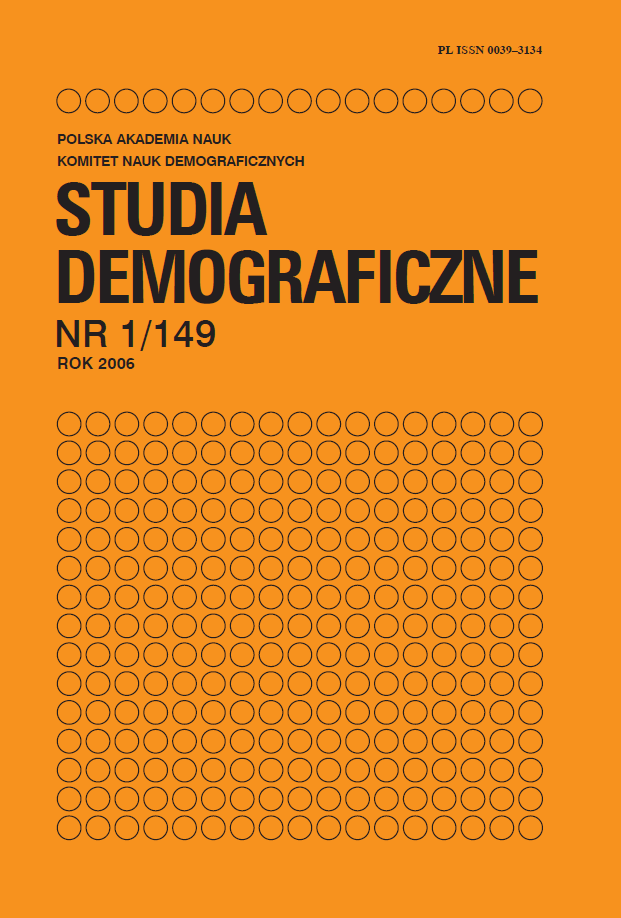Analiza umieralności w Polsce w latach 1970–2003. Dekompozycja zmian w oczekiwanym trwaniu życia noworodka
Main Article Content
Abstract
Advantageous changes in male and female mortality taken place in Poland since the early 1990s placed the life expectancy of Poles among the highest in the Central and Eastern Europe. However, that indicator is still far behind the European countries which benefit from the highest life expectancies. The life expectancy values in Poland are currently at levels observed in these countries 30 years ago for males and 20 years ago for females. A gender gap in the life expectancy also remains high, especially in the middle-aged population. The method proposed by E.Arriaga (1984) was used to decompose changes in the life expectancy by age in Poland over the subsequent decades from 1970/1971 to 2003. The period before 1989 was used to show differences in mortality changes between these two time intervals. Disadvantageous trends in mortality among middle-aged men had been observed in Poland as early as the mid 1970s. In the recent years (1991-2003), beneficial shifts in mortality were observed in all age groups, resulting in the increase in the life expectancy at birth. Results of the analysis of differences in life expectancies by gender confirmed a significant contribution of the middle-aged groups to the gender gap. Shifts in mortality are more advantageous for women in the older age groups, which may stimulate a further growth in the number of single old women in Poland.
Article Details
References
[2] Arriaga E., 1984, Measuring and explaining the change in life expectancies, “Demography” 21, s. 83–96.
[3] Bobak M., 1999, Health and mortality trends in countries with economies in transition. In: Health and Mortality. Issues of Global Concern. Proceedings of the Symposium on Health and Mortality. Brussels, 19–22 November 1997, New York, United Nations, pp. 203–226.
[4] Chenet L., McKee M., Fulop N., Bojan F., Brand H., Hort A., Kalbarczyk P., 1996, Changing life expectancy in Central Europe: is there a single reason, “Journal of Public Health Medicine” 18, s. 329– 6.
[5] Keyfitz N., 1977, Applied Mathematical Demography, New York, Wiley.
[6] Kędelski M., 1993, Regres demograficzny w Polsce 1981–1992, „Studia Demograficzne” 2(112), s. 3–14.
[7] Kuropka I., 1999, Natężenie zgonów według wieku jako czynnik przyrostu trwania życia ludności Dolnego Śląska w latach 1980–1998, „Studia Demograficzne” 2(136), s. 3–16.
[8] Kuropka I., 2002, Potencjał życiowy mieszkańców Dolnego Śląska. Diagnoza i perspektywy, AE, Wrocław.
[9] Mesle F., 2004, Mortality in Central and Eastern Europe: long-term trends and recent upturns, “Demographic Research”, Special Collection 2: Article 3, Published 16 April 2004: www.demographic-research.org
[10] Nolte E., Shkolnikov V., McKee M., 2000, Changing mortality patterns in East and West Germany and Poland, J Epidemiol Community Health 54, s. 899–906.
[11] Okólski M., 1987, Umieralność mężczyzn w Europie Wschodniej i Europie Zachodniej, „Studia Demograficzne” 3(89).
[12] Pollard J.H., 1982, The expectation of life and its relationship to mortality, “Journal of the Institute of Actuaries” 109, s. 225–240.
[13] Pollard J.H., 1988, On the decomposition of changes in expectation of life and differentials in life expectancy, “Demography” 25/2, s. 265–276.
[14] Rutkowska L., 1999, Prognoza umieralności w Polsce do 2050 r., „Studia Demograficzne” 2(136), s. 17–1.
[15] Tabeau E., 1996, Mortality in Poland in 1989–93: a response to economic reforms?, “Studia Demograficzne” 1–2(123–124), s. 13–37.
[16] Watson P., 1995, Explainning rising mortality among men in Eastern Europe, “Social Science and Medicine” 41, s. 923–934.
[17] World Bank, 1998, World development indicators. Washington, D.C.World Bank 1998.
[18] Zatoński W., 2000, The health transformation in Eastern Europe after 1990: A second look, Paper at the Conference on Health status of Central and Eastern European Populations after transition, June 2000, Warsaw.
Opracowania statystyczne GUS
[1] Bolesławski L., 1996, Trwanie życia i umieralność według przyczyn w 1995 r., GUS, Studia i Analizy Statystyczne.
[2] Polskie tablice wymieralności 1960/61 (oprac. J.Z. Holzer), GUS, Statystyka Polski, 1964.
[3] Polskie tablice trwania życia 1970/72 (oprac. J. Aleksińska, Z. Gałązka) GUS, Statystyka Polski, 18/1973.
[4] Polskie tablice trwania życia 1980/81 (oprac. L. Nowak) GUS, Studia i Prace, 1983.
[5] Polskie tablice trwania życia 1990/91 (oprac. J. Mijakowska) GUS, Studia i Analizy Statystyczne, 1993.
[6] Roczniki Demograficzne z lat 1990–2005, Warszawa, GUS.
[7] Rutkowska L., 2005, Trwanie życia w 2004 r., GUS, Informacje i opracowania statystyczne.
[8] Tablice trwania życia w 1991 r. (przeliczone według metody stosowanej od 1995 r.), GUS, materiały niepublikowane.
